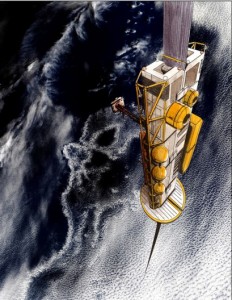August 28, 2014 – Back from an enjoyable vacation that included a visit to Chicago’s Museum of Science and Industry, which I promise to write about in the next few days. While away I read about LiftPort Group, a Kickstarter-funded space elevator project that received over $110,000 U.S. from more than 3,400 backers. The company, located in Tacoma, Washington, originally sought $8,000, so one would think this was largely fantasy, but with the amount of money that has come in it would seem it owes its investors something more than one it has delivered to-date.
And what exactly has been delivered since the Kickstarter campaign closed in September of 2012? What the Kickstarter campaign money was to fund was a lunar space elevator. But not much has happened since 2012 when you look at the website. Click on Space Elevator and there’s nothing there. Click on other pages and you get vision and mission statements, and a bit of discussion about the physics and science behind a lunar elevator. The progress reports are anything but.
But NBC News in the last couple of days has suddenly put LiftPort Group back in the headlines with a story about an upcoming test involving the launching of a high-altitude balloon with a 7 kilometer (4.5 mile) vectan-polymer string attached. The goal – to have a multi-wheeled, solar-powered robotic climber (see image below) do a high-wire act by ascending that string to the balloon as a proof of concept. The balloon experiment still needs approval from the U.S. Federal Aviation Administration but once that is given LiftPort will launch somewhere on the Olympic Peninsula in the state of Washington.
It was Arthur C. Clarke, one of my favorite sci-fi writers, who first popularized the notion of a space elevator. At the time it seemed far reaching to say the least. But Clarke also had predicted earth communication satellites back in the 1940s and saw them realized by the 1960s. So maybe the space elevator will one day come of age just as Clarke predicted.
If the upcoming balloon experiment succeeds, the LiftPort Group will next attempt to put a nano-satellite counterweight in space with a trailing tether and have their robotic climber make the trek from Earth to it. But the balloon launch is still pending. And the website talks about deployment of a working space elevator infrastructure by 2019, a mere five years away. What’s needed of course is material produced in quantity that is both light-weight and strong and can support a robotic climber carrying a payload.
Carbon nanotubes appear to be the material of choice. According to ISEC (the International Space Elevator Consortium) a cable 7 centimeters (2.75 inches) thick could support the daily lifting of 1,000 tons of payload from the Earth’s surface to space. ISEC even projects a time in the future when space elevators would be used as launch platforms for interplanetary space travel. At its most recent annual conference at the Musem of Flight in Seattle, Washington, teams of scientists from all around the world gathered to discuss progress in the field. Europe, Japan and the United States are in the forefront of this technology. The ISEC peer-reviewed journal, CLIMB, published since 2010 provides the latest science on the subject. Trust me, no one at the conference was laughing about what at times seems to be a somewhat bizarre idea.
And why aren’t they laughing? Because a working space elevator would make access to space cheap and simple. It would be like riding the elevator in a high-rise building. With a space elevator building a space infrastructure and human colonization would be far more affordable than what we humans are doing currently with throw-away chemical rockets and limited payloads.



















